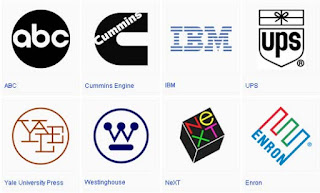 |
| Picture found here. |
 |
| Book cover design by Paul Rand. Picture found here. |
 |
| Book covers designed by Paul Rand. Picture found here. |
"Rand devoted his final years to design work and the writing of his memoirs. In 1996, he died of cancer at age 82 (November 26th, 1996) in Norwalk, Connecticut. He is buried in Beth El Cemetery." (Source #2)
 |
| Logos designed by Paul Rand. Picture found here. |
"The International Typographic Style, also known as the Swiss Style, is a graphic design style developed in Switzerland in the 1950s that emphasizes cleanliness, readability and objectivity. Hallmarks of the style are asymmetric layouts, use of a grid, sans-serif typefaces like Akzidenz Grotesk, and flush left, ragged right text. The style is also associated with a preference for photography in place of illustrations or drawings. Many of the early International Typographic Style works featured typography as a primary design element in addition to its use in text, and it is for this that the style is named.
 |
| Book cover design by Paul Rand. Picture found here. |
About His Work & Influences: "Though Rand was a recluse in his creative process, doing the vast majority of the design load despite having a large staff at varying points in his career, he was very interested in producing books of theory to illuminate his philosophies. László Moholy-Nagy may have incited Rand's zeal for knowledge when he asked his colleague if he read art criticism at their first meeting. Rand said no, prompting Moholy-Nagy to reply "Pity." Steven Heller ( wrote "Thoughts on Rand" for Print magazine in May–June 1997 edition) elaborates on this meeting's impact, noting that, "from that moment on, Rand devoured books by the leading philosophers on art, including Roger Fry, Alfred North Whitehead, and John Dewey." These theoreticians would have a lasting impression on Rand's work; in a 1995 interview with Michael Kroeger discussing, among other topics, the importance of Dewey's Art as Experience, Rand elaborates on Dewey's appeal:
 |
| Book cover design by Paul Rand. Picture found here. |
'[. . . Art as Experience] deals with everything — there is no subject
he does not deal with. That is why it will take you one hundred years
to read this book. Even today's philosophers talk about it[.]
[E]very time you open this book you find good things.
I mean the philosophers say this, not just me. You read this,
then when you open this up next year, that you read something new.'
 |
| A set of children's books designed by Paul Rand. Picture found here. |
Effect On Graphic Design: "Rand's most widely known contributions to design are his corporate identities, many of which are still in use. IBM, ABC, Cummins Engine, UPS, and the now-infamous Enron, among many others, owe Rand their graphical heritage. One of his strengths, as Moholy-Nagy pointed out, was his ability as a salesman to explain the needs his identities would address for the corporation. According to graphic designer Louis Danziger:
'He almost singlehandedly convinced business that design
was an effective tool. [. . .] Anyone designing in the 1950s and 1960s
owed much to Rand, who largely made it possible
for us to work. He more than anyone else made the profession
reputable. We went from being commercial artists to being
graphic designers largely on his merits.'
 |
Book cover design
by Paul Rand.
Picture found here.
|
 |
| Paul Rand's book Thoughts On Design. Picture found here. |
Bibliography:
Sources:
- #1 - http://www.kettererkunst.com/bio/paul-rand-1914.shtml
- #2 - http://en.wikipedia.org/wiki/Paul_Rand
- #3 - http://en.wikipedia.org/wiki/International_Typographic_Style
- Rand, Paul (1970). Thoughts On Design. Studio Vista Van Nostrand Reinhold. ISBN 978-0289798362.
- Rand, Paul (1985). Paul Rand: A Designer's Art. New Haven: Yale University Press. ISBN 978-0300082821.
- Rand, Paul (1994). Design, Form, and Chaos. New Haven: Yale University Press. ISBN 978-0300055535.
- Rand, Paul (1996). From Lascaux to Brooklyn. New Haven: Yale University Press. ISBN 978-0300066760.
Sources:
- #1 - http://www.kettererkunst.com/bio/paul-rand-1914.shtml
- #2 - http://en.wikipedia.org/wiki/Paul_Rand
- #3 - http://en.wikipedia.org/wiki/International_Typographic_Style
Also, this video, which I first saw here:

No comments:
Post a Comment